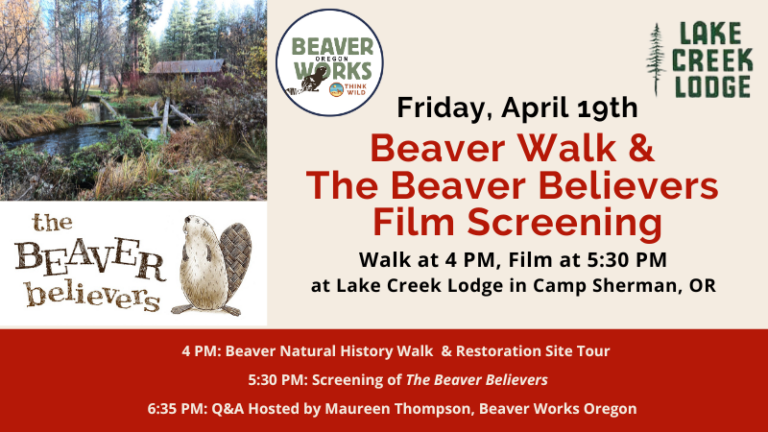Beaver Habitat Planting at Lake Creek Lodge
Beaver Habitat Planting at Lake Creek Lodge in Camp Sherman
To restore riparian habitat and improve local conditions for beaver repopulation, in May of 2024, Think Wild staff and 16 volunteers spent two days planting four enclosures with 1,000 willows in 50 cottonwood sticks, 20 red osier dogwood sticks, and 11 aspen saplings. The live stick species co-evolved with beaver, so they grow into trees from just branch segments and respond to damage with regrowth.
Over the next 3-5 years, these sticks will grow into willow and cottonwood plants that will provide long-term forage and habitat elements for beavers as well as directly and indirectly support other local aquatic and terrestrial wildlife.




Site History
Lake Creek Lodge is located in Camp Sherman, Oregon, with the South Fork of Lake Creek (an outlet of Suttle Lake) running through it with the tributary junction to the Metolious River less than a mile downstream. Because of its unusual geology, ecology, fish and wildlife, and cultural and recreational history, the Metolius River is protected by the National Wild and Scenic River Act of 1988 and Oregon’s Metolius Protection Act. In 2009, the legislature designated the 448 square miles of the Metolius River basin as an Area of Statewide Concern.
This private property ideally situated on a tributary to the Metolious River hosts significant wildlife viewing opportunities and a long history of stewardship. Gordon and Jeff Jones acquired this bucolic lodge and cabin property in 2003, and started to remove the thicket of black hawthorn thicket resulting from the site’s historic use as a horse pasture.
Starting in 2006, through a partnership among Lake Creek Lodge, the Upper Deschutes Watershed Council, and the Deschutes National Forest, riparian and in-stream habitat restoration was initiated to stabilize the stream channel and increase the availability of pools and off-channel habitat for the subsequent reintroduction of steelhead, chinook, and sockeye salmon.
Camp Sherman is a quiet, unincorporated community with a number of accommodations for visitors, making nature-focused tourism one of the main attractions. Like much of the East Cascades, the resident community wrestles with fire safety and recreational use and development increases. There are beaver sightings and beaver sign within the Lake Creek tributaries, but beaver-modified habitat existed in living history.
Community Engagement through a natural history walk and a movie

In advance of the habitat restoration project, we wanted to engage the community in the story of beavers as native keystone species, our habitat-forward methods of beaver habitat restoration, and the vision for the project at Lake Creek Lodge. Camp Sherman has ~300 residents, so we expected a few people… Over 80 people came out to learn about beavers! The event started with a nature walk where participants learned about beaver biology, interactions between beaver and riparian ecosystems, and ways beavers can both benefit us as human neighbors as well as coexistence strategies for living alongside beavers. We then watched the 2018 documentary The Beaver Believers – a film that follows five passionate, self-proclaimed “beaver believers” located in five states across the west as they work to better understand and support beavers. Earlier in the day, 12 kids from the nearby Black Butte School also took a field trip to meet with Beaver Works Oregon and watch the film. We were thrilled to see such a high level of beaver curiosity and enthusiasm from the community!




Site Assessment
In the fall of 2023, while presenting on beaver human co-existence past, present, and future at Paulina Springs Bookstore in Sisters, OR, Beaver Works staff met attendee and local landowner Gordon Jones. Later that month, we walked the property and neighboring streams to conduct a suitability assessment for beaver habitat restoration and learn the site history from residents. This stream section has a natural wet meadow, potentially a relic of beavers past. This section is quite bucolic, has deep perennial, somewhat channelized stream flow but has human infrastructure with potential to be affected by beaver activity.



Monitoring and Project Development
We’re looking forward to continuing to work in this unique natural area for more beaver co-existence promotion and post-project monitoring in the near future. Read on for updates, footage from our on- site trail camera, and ways to get involved this fall.

